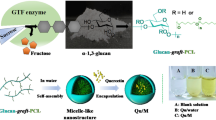Abstract
Chitosan, a natural polycationic polysaccharide, was coupled with two polyanionic polymers: Na-alginate and carboxymethylcellulose (CMC) and with tannic acid (TA) obtaining three species of self-assembled complexes: chitosan/alginate/TA (sample 1), chitosan/TA (sample 2) and chitosan/CMC/TA (sample 3). The microparticle formation was achieved by dropwise addition of one solution into other by using a coaxial airflow sprayer. These systems were characterized with regard to particle size distribution, thermal stability, tannic acid entrapment efficiency. Sample 2 showed quite a different behavior compared to the other two samples; the particle diameter is located in the nanometric region, the quantity of incorporated tannic acid is higher than in the other two samples and the material shows better thermal stability. The release of tannic acid from these complexes was studied in water (pH = 5.89), phosphates buffer (pH = 7.04) and acetate buffer (pH = 4.11). These studies revealed two distinct periods in tannic acid delivery process: an initial period, varying between 4 and 10 h, characterized by a high release rate with a delivered tannic acid amount of approximately 80% of the incorporated polyphenol and a second period, which starts after 20 to 30 h of delivery and it ends after approximately 120 h, when the release process takes place with low and constant rate and the kinetic curve is linear—characteristic for a zero order kinetic.






Similar content being viewed by others
References
K.T. Chung, T.Y. Wong, C.I. Wei, Y.W. Huang, Y. Lin, Crit. Rev. Food Sci. Nutr. 38(6), 421 (1998). doi:10.1080/10408699891274273
C. Nepka, E. Asprodini, D. Kouretas, Eur. J. Drug Metab. Pharmacokinet. 24, 183 (1999)
H.U. Gali-Muhtasib, S.Z. Yamout, M.M. Sidani, Nutr. Cancer 37, 73 (2000). doi:10.1207/S15327914NC3701_9
C. Nepka, E. Sivridis, O. Antonoglou, A. Kortsaris, A. Georgellis, I. Taitzoglou, P. Hytiroglou, C. Papadimitriou, Kouretas.D. Zintzaras, Cancer Lett. 14, 57 (1999). doi:10.1016/S0304-3835(99)00145-7
N. Sangkil, D.M. Smith, Q. Ping Dou, Cancer Epidemiol. Biomarkers Prev. 10, 1083 (2001)
J.W. Dollahite, R.F. Pigeon, B.J. Camp, Am. J. Vet. Res. 23, 1264 (1962)
S. Dumitriu, E. Chornet, Adv. Drug Deliv. Rev. 31, 223 (1998). doi:10.1016/S0169-409X(97)00120-8
O. Gaserod, O. Smidsrod, G. Skjak-Brek, Biomaterials 19, 1815 (1998). doi:10.1016/S0142-9612(98)00073-8
O. Gaserod, A. Sannes, G. Skjak-Brek, Biomaterials 20, 773 (1999). doi:10.1016/S0142-9612(98)00230-0
M.G. Sankalia, R.C. Mashru, J. Sankalia, V.B. Mand Sutariya, Eur. J. Pharm. Biopharm. 65, 215 (2007). doi:10.1016/j.ejpb.2006.07.014
S. Ichikawa, S. Iwamoto, Watanabe, Biosci. Biotechnol. Biochem. 69, 1637 (2005). doi:10.1271/bbb.69.1637
T. Yoshioka, R. Hirano, T. Shioya, M. Kako, Biotechnol. Bioeng. 35, 35 (1990). doi:10.1002/bit.260350110
T. Peng, K.D. Yao, Z. Chen, M.F. Goosen, J. Polym. Sci. Polym. Chem. Ed. 32, 591 (1994). doi:10.1002/pola.1994.080320322
T. Sannan, K. Kurita, K. Ogura, Y. Iwakura, Polymer 18, 458 (1978). doi:10.1016/0032-3861(78)90256-2
Acknowledgements
This work was supported in part by CEEX 108/2006 project. The thermal analysis was carried out on a Mettler Toledo derivatograph within the Platform “High performance multi-functional polymeric materials for medicine, pharmacy, micro-electronics, energy/information storing, and environment protection” funded by CNCSIS through project no. 69/2006.
Author information
Authors and Affiliations
Corresponding author
Rights and permissions
About this article
Cite this article
Aelenei, N., Popa, M.I., Novac, O. et al. Tannic acid incorporation in chitosan-based microparticles and in vitro controlled release. J Mater Sci: Mater Med 20, 1095–1102 (2009). https://doi.org/10.1007/s10856-008-3675-z
Received:
Accepted:
Published:
Issue Date:
DOI: https://doi.org/10.1007/s10856-008-3675-z




